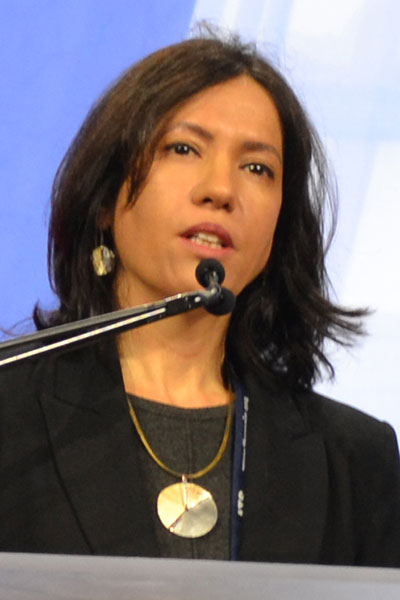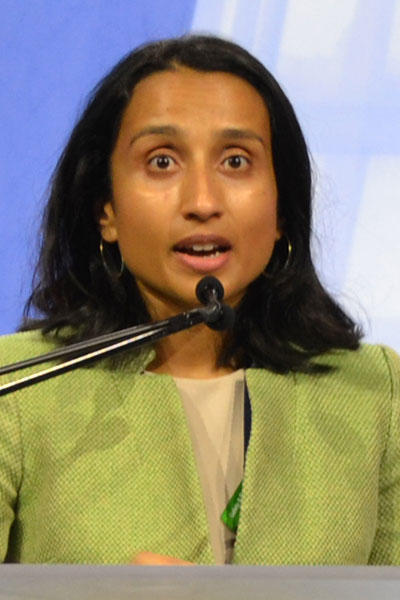The fourth and final session of the annual Clinical Year in Review focused on cutting-edge research in lung transplantation, medical education, health disparities, and cystic fibrosis and non-CF bronchiectasis. Some of the papers reviewed have already influenced changes within the ATS. This session will be included in the On-Demand Highlights available in the ATS Store this summer.
Lung Transplantation

Half of all lung transplant recipients die within five to seven years of receiving their new organs.
“That is completely unacceptable,” said Sean Agbor, MD, PhD, Lasker Clinical Research Fellow and lab chief, National Heart, Lung and Blood Institute Laboratory of Applied Precision Omics, and associate professor, Lung Transplant Program, Johns Hopkins University.
Dr. Agbor outlined two novel platforms that may improve the current survival rate. The first is an ex vivo delivery system of regulatory T cells that can control alloimmune priming in the donor lung. Mouse models show that lung function is preserved through perfusion with regulatory T cells as Treg cell counts decline by about 50 percent.
A second paper found that bronchoalveolar lavage before organ procurement and six hours after transplantation can assess changes in the graft microbiome. Increases in oropharyngeal microbes, pepsin, and inflammatory cytokines predict graft rejection.
“These platforms are signs of hope,” Dr. Agbor said. “I can envision all sorts of ways you can manipulate these platforms to improve graft survival and patient outcomes.”

Medical Education
A 12-month pilot program at Brown University found that academic pulmonary care, critical care, and sleep medicine faculty and fellows are eager to engage with an antiracism curriculum and agree that they benefit from the program.
The program used 13 one-hour Zoom sessions during an existing didactic time slot. Pre- and post-course surveys found near-universal agreement that discrimination based on race occurs in medicine.
“There was a strong belief that racism has consequences for patients,” said Juliana C. Ferreira, MD, PhD, ATSF, assistant professor of medicine, University of Sao Paulo, Sao Paulo, Brazil.
A second study piloted an online reporting program for mistreatment in a large academic medical center with more than 6,000 participants. The program used definitions of mistreatment from the American Association of Medical Colleges.
Of 196 reports, 173 included maltreatments — most often public embarrassment or humiliation, offensive remarks, or denied training. Most of the reports, 61 percent, involved faculty behavior, Dr. Ferreira reported, and 10 faculty accounted for half of the reports. Ten faculty reports were handled orally, and 10 resulted in formal proceedings, she added.
Health Disparities

Race correction in spirometry equations does not work. That is the clear conclusion from two recent studies examining the differences between race-neutral and race-based coefficients.
“These race-based coefficients are not clinically derived,” said Deepshikha Charan Ashana, MD, MBA, MS, assistant professor of medicine and assistant professor of population health sciences, Duke University School of Medicine. “Black patients in particular with low FEV1 may be classified as having normal spirometry, with negative implications for diagnosis, medication, recognition of occupational hazards, and referrals for transplantation.”
The MESA study found that race- and ethnicity-based spirometry equations consistently underperformed race-neutral equations, Dr. Ashana said. A subanalysis of the SPIROMICS cohort found that race-neutral equations better model the relationship between spirometry and most outcomes.
These two studies, with other information, prompted the ATS to issue an official statement in 2023 asserting the inclusion of race/ethnicity in spirometry reference equations does not improve prediction of clinical outcomes.
CF/Non-CF Bronchiectasis

The 2019 approval of triple therapy with elexacaftor/tezacaftor/ivacaftor (ETI) meant the promise of effective treatment for most patients with CF. The PROMISE study found similar benefits in real-world populations for up to 30 months.
After a mean of six months on ETI, the mean predicted percentage of FEV1 was 91 percent, and sweat chloride declined by 42 nmol/L, reported Simone Visser, MBBS, BPharm, PhD, Royal Prince Alfred Hospital, Sydney, Australia. Patients had a mean increase of 20 points on the CF Questionnaire-revised respiratory domain (CFQ-R RD), and 35 percent had the maximum CFQ-R RD score. Mean body mass index improved, and about one-third of patients stopped usual therapies, such as inhaled antibiotics and hypertonic saline, on their own.
“The results we see with patients in the real world are substantially similar to clinical studies in a broader, real-world population,” Dr. Visser said.
The SIMPLIFY trial focused on the discontinuation of hypertonic saline or dornase alfa in people with CF on ETI or other modulator therapy. The mean age was 22 years with a mean ppFEV1 of 97 percent, although 10 percent of participants had a ppFEV1 of less than 70 percent.
Discontinuation of either hypertonic saline or dornase alfa had no effect on ppFEV1 at a scheduled six-month interim analysis, Dr. Visser reported, although there were adverse respiratory events in both groups. Patients with ppFEV1 of less than 70 percent were more likely to have adverse events, she noted.
Extend Your Learning Beyond San Francisco with ATS 2025 Conference Highlights

With so many valuable educational opportunities offered during the ATS 2025 International Conference, attendees are often forced to decide which sessions to prioritize. That’s why the Society is offering three ATS 2025 Conference Highlights packages for those unable to attend ATS 2025 San Francisco or attendees interested in continuing their education after the conference. Check out the packages and pick the one that’s right for you. Learn at your own pace, whenever and wherever you are!

